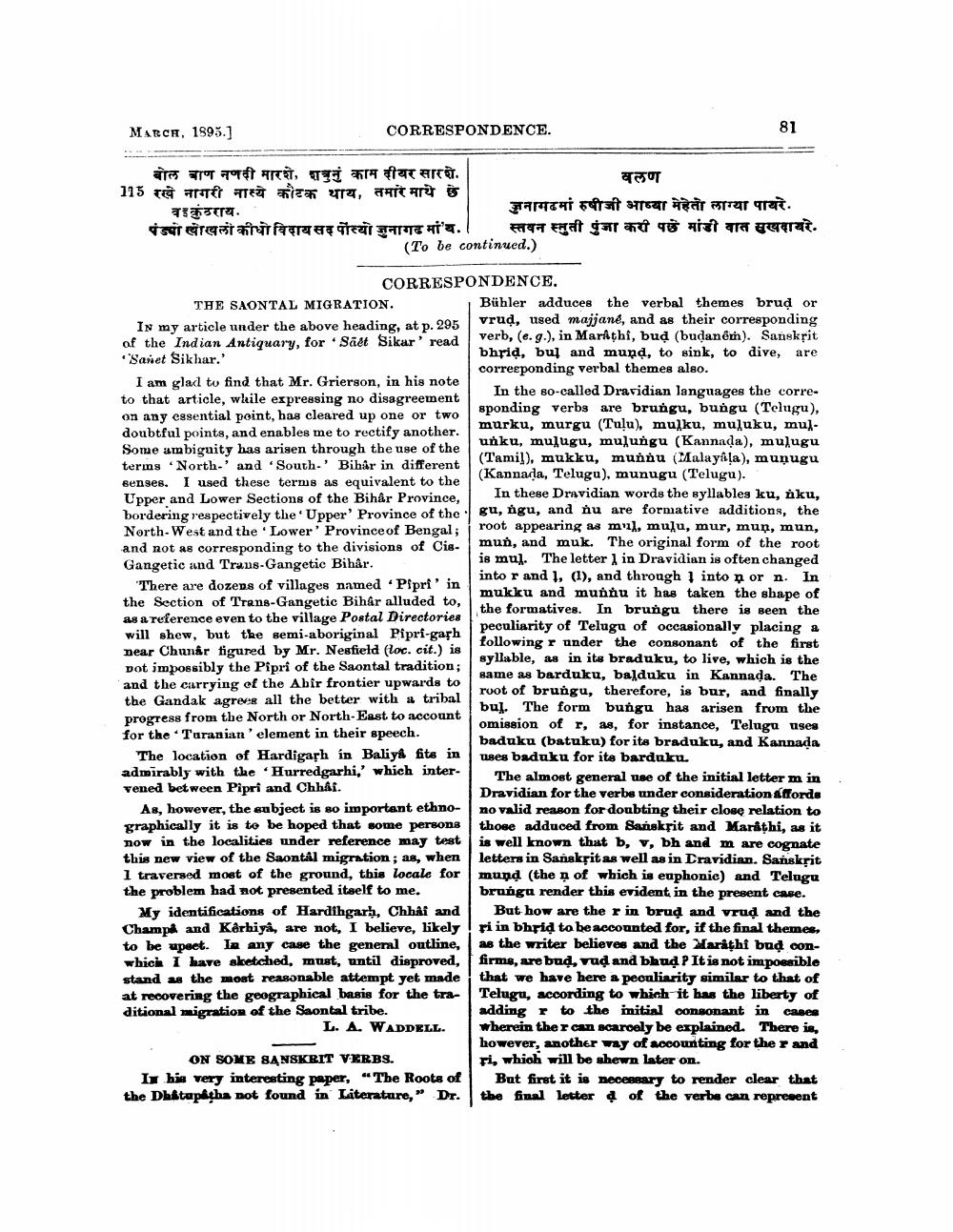________________
MARCA, 1995.]
CORRESPONDENCE.
बोल बाण नणदी मारशे, शत्रुन काम दीयर सारशे.
वलण 115 रखे नागरी नास्ये कौटक थाय, तमारे माये छ वाकुंठराय.
जनागढमां रुषीजी आष्या मेहेतो लाग्या पायरे. पंड्या खोखली कीधोविदायसद पौत्यो जुनागढ माय.। स्तवन स्तुती पुजा करी पछे मांडी वात सुखदायरे.
(To be continued.)
CORRESPONDENCE. THE SAONTAL MIGRATION.
| Bühler adduces the verbal themes brud or In my article under the above heading, at p. 295
vrud, used majjane, and as their corresponding of the Indian Antiquary, for Sãết Sikar' read
verb, (e.g.), in Markthi, bud (budanêm). Sanskrit •Sanet Sikhar.'
bhrid, bul and mund, to sink, to dive, are
correeponding verbal themes also. I am glad to find that Mr. Grierson, in his note to that article, while expressing no disagreement
In the so-called Dravidian languages the corre. on any essential point, has cleared up one or two
sponding verbs are brungu, bungu (Telugu), doubtful points, and enables me to rectify another.
murku, murgu (Tulu), mulku, muluku, mul
unku, mulugu, mulungu (Kannada), mulugu Some ambiguity has arisen through the use of the
(Tamil), mukku, munu Malayaļa), muņugu terms North-' and South.' Bihar in different Benses. I used these terms as equivalent to the
(Kannada, Telugu), munugu (Telugu). Upper and Lower Sections of the Bihar Province,
In these Dravidian words the syllables ku, nku, bordering respectively the Upper' Province of the gu, ngu, and nu are formative additions, the North-West and the Lower' Province of Bengal;
root appearing as mil, mulu, mur, mun, mun, and not as corresponding to the divisions of Cis
mun, and muk. The original form of the root Gangetic and Trans-Gangetic Bihar.
is mul. The letter 1 in Dravidian is often changed
into r and 1, (l), and through 1 into por n. In "There are dozens of villages named 'Pipri' in
mukku and munnu it has taken the shape of the Section of Trans-Gangetic Bihar alluded to,
the formatives. In brungu there is seen the as a reference even to the village Postal Directories
peculiarity of Telugu of occasionally placing a will shew, but the semi-aboriginal Pipri-gash
following r under the consonant of the first near Chunar tigured by Mr. Nesfield (loc. cit.) is
syllable, as in its braduku, to live, which is the pot impossibly the Pipri of the Saontal tradition;
same as barduku, balduku in Kannada. The and the carrying of the Abîr frontier upwards to
root of brungu, therefore, is bur, and finally the Gandak agrere all the better with a tribal
bu). The form bungu has arisen from the progress from the North or North-East to account
omission of r, as, for instance, Telugu uses for the Turanian'element in their speech.
baduku (batuku) for its braduku, and Kannada The location of Hardigarh in Baliye fits in
uses badaku for its barduku. admirably with the Hurredgarhi,' which inter
The almost general use of the initial letter m in vened between Pipri and Chhải.
Dravidian for the verbs under consideration Affords As, however, the subject is so important ethno- no valid reason for doubting their close relation to graphically it is to be hoped that some persons those adduced from Sanskrit and Marathi, as it now in the localities under reference may test is well known that b, v, bh and m are cognate this new view of the Saontal migration; as, when letters in Sanskrit as well as in Dravidian. Sanskrit I traversed most of the ground, this locale for mund (the ~ of which is euphonie) and Telugu the problem had not presented itself to me. brunga render this evident in the present case.
My identifications of Hardfhgarh, Chhai and But how are the r in brud and vrud and the Champol and Kórhiya, are not, I believe, likely ri in bhrid to be accounted for, if the final themes, to be upect. In any case the general outline, as the writer believes and the Marathi bad conwhicis I have sketched, must, until disproved, firms, are bud, vad and bhad P It is not impoesible stand as the most reasonable attempt yet made that we have here a peculiarity similar to that of at recovering the geographical basis for the tra- Telugu, according to which it has the liberty of ditional migration of the Saontal tribe.
adding r to the initial consonant in cases L. A. WADDELL. wherein ther can acarcely be explained. There is,
| however, another way of accounting for the r and ON SOME SANSKRIT VERBS.
Fi, which will be shewn later on. It his very interesting paper, “The Roots of But first it is necessary to render clear that the Dhitapitha not found in Literature," Dr. the final letter of the verbe can represent




